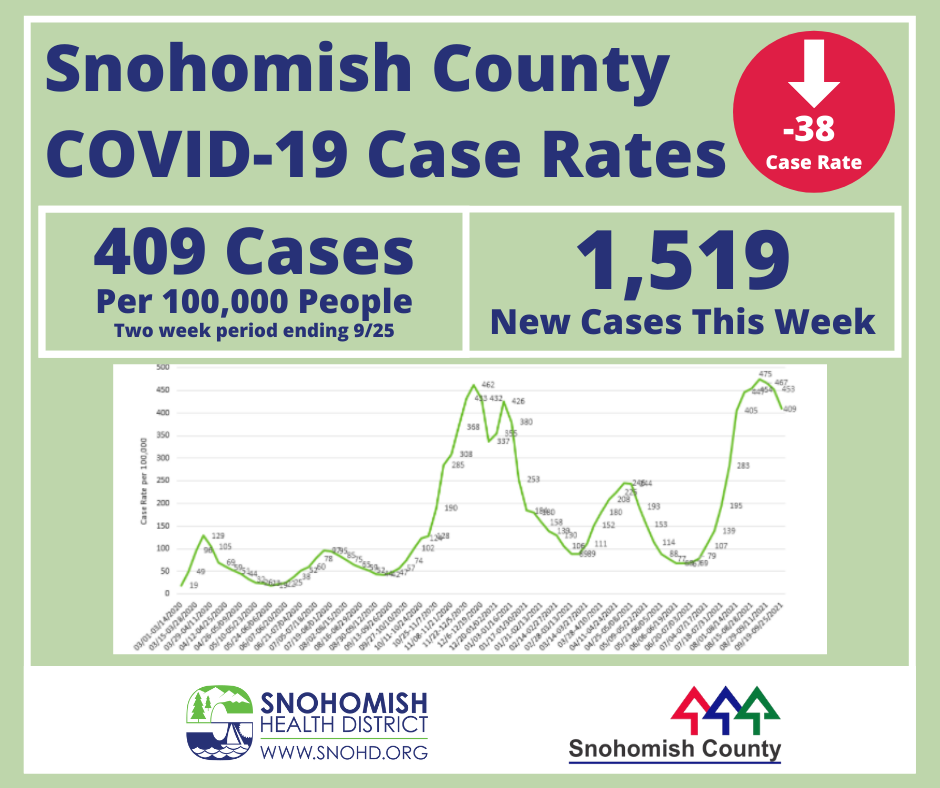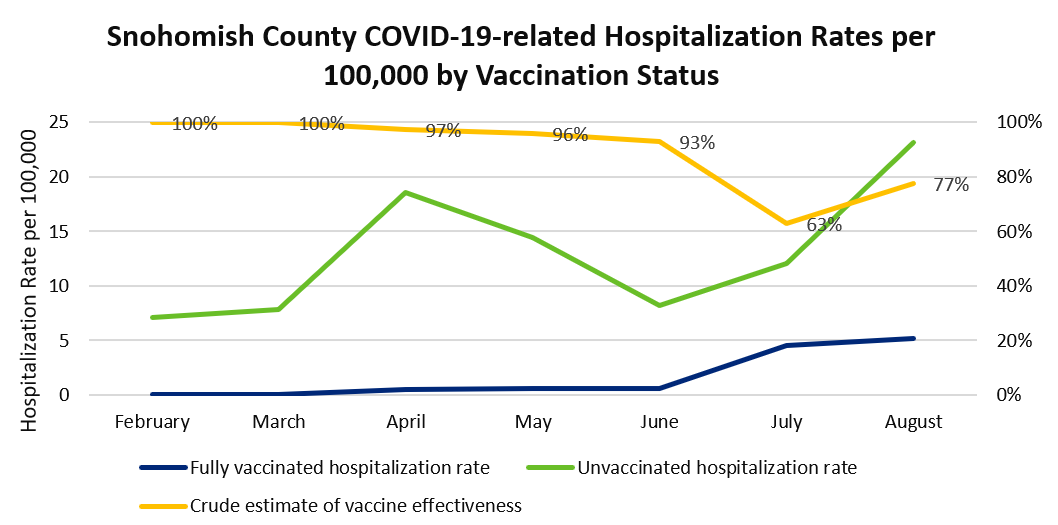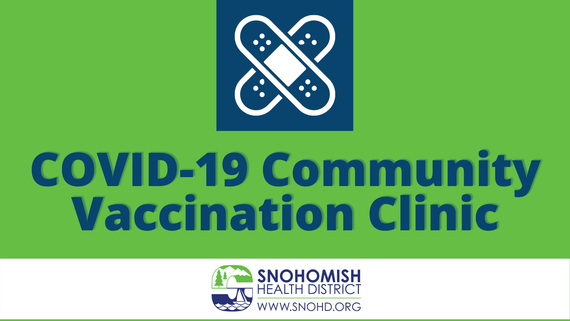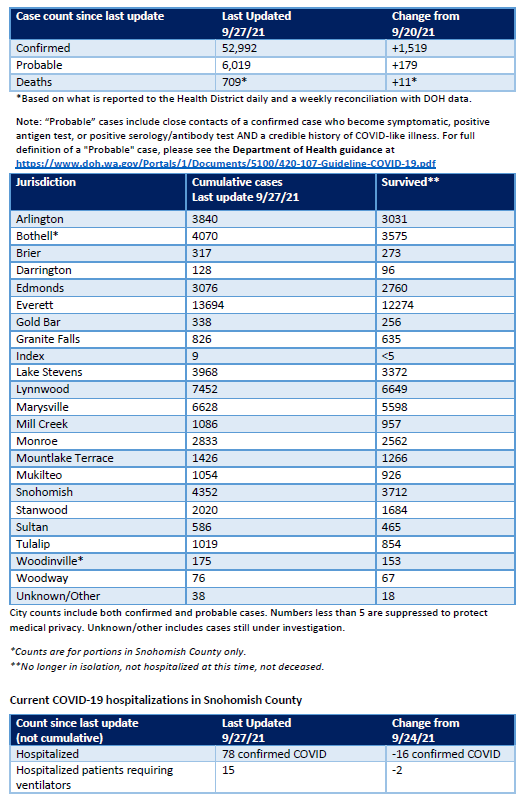|
|
The COVID-19 case rate in Snohomish County is continuing to decline, although it is still high with 409 new cases per 100,000 people. With flu season coming up, it is a time for extra caution, particularly if hospitals are going to keep up. Remember to mask up, vax up, and stay home if sick. Have symptoms? Get tested: www.snohd.org/testing.

|
|
|
Snohomish County Executive Dave Somers on Tuesday submitted his proposed 2022 budget to the Snohomish County Council. The proposed budget includes over $56 million dollars in Federal American Rescue Plan Act funds approved by Congress. The total budget for all funds was $1,255,624,596.
“Once a year, we have an opportunity to present our vision for the future in the form of our proposed budget,” said Executive Dave Somers. “For 2022, we are focused on improving public safety, advancing social justice, protecting our environment, supporting community health, and strengthening our economy. Snohomish County will focus on our areas of greatest need by funding programs that will improve our quality of life and serve the whole of the community. Too many have suffered from the effects of the COVID-19 pandemic—not only the health impacts of the disease but also the many challenges that the pandemic has made more visible. From the urgent need for more housing to mental health and substance abuse treatment, we have an opportunity to reduce suffering, build safer communities, and improve the quality of life for many of Snohomish County’s residents.”
See the full press release for more information or watch a video of Executive Somers’ budget address.

|
|
|
The COVID-19 vaccines continue to be remarkably effective in reducing risk of severe disease, hospitalization, and death, including against the delta variant. We continue to see highly effective protection against hospitalizations and severe outcomes for people who are fully vaccinated.
In its latest data report, the Snohomish Health District provided an updated look at cases by vaccination status. The rate of unvaccinated individuals requiring hospitalization due to COVID-19 increased significantly in August compared to those fully vaccinated.
This trend also held true when looking at vaccination status among those who died from COVID-19. Of the 137 residents who have died from COVID-19 since January 2021, 93% were unvaccinated.
In addition to the report, the Health District’s recently published new heat and ZIP code maps show that the ZIP codes in Snohomish County with the lowest vaccination rates are also among the high case rates during the period ending September 11.
See the full press release for more information.
| Month |
Total COVID-19 deaths |
COVID-19 Vaccine breakthrough deaths |
Percent vaccinated |
| February |
27 |
0 |
100% |
| March |
18 |
0 |
100% |
| April |
13 |
0 |
100% |
| May |
21 |
0 |
100% |
| June |
17 |
<5 |
94% |
| July |
14 |
<5 |
71% |
| August |
27 |
5 |
81% |
| Total |
137 |
10 |
93% |

|
|
|
The CDC has recommended Pfizer boosters be given six months after their second dose for:
- Older adults 65 and older, and those living in long-term care facilities.
- Adults 50-64 at high risk of severe COVID-19, due to underlying medical conditions.
- Adults 18-49 at high risk of severe COVID-19 due to underlying medical conditions should consider a booster based on an assessment of their individual benefits and risks and consultation with their medical provider.
- Adults 18-64 whose jobs put them at high risk for COVID-19.
As the science and the virus evolves, so do policies and recommendations. Booster doses are common for many vaccines. The scientists and medical experts who developed the COVID-19 vaccines continue to closely watch for signs of waning immunity, how well the vaccines protect against new mutations of the virus, and how that data differs across age groups and risk factors.
Thousands of Snohomish County residents may now be eligible for booster shots, but there’s more guidance coming for others. Pfizer was the first vaccine to be authorized, which means its data on its ongoing effectiveness was also available first. Guidance is still forthcoming about boosters for the Johnson & Johnson and Moderna vaccines and the safety of mixing different vaccines, as well as information on potential expansion of Pfizer vaccine eligibility for those 5-11 years old.
If you are eligible for a Pfizer booster, please contact your healthcare provider or local pharmacy. While the CDC and FDA have recommended the Pfizer boosters, residents may need to wait a few days for registration and screening systems to be updated. Please be patient while everyone is making these necessary adjustments.
See the full press release for more information.
|
|
|
Nearly three-quarters of eligible people 12 and up in Snohomish County now have at least initiated vaccination. Another 4,635 people last week initiated vaccination against COVID-19 and 5,327 completed the series. That’s down a little from the week prior, but still nearly 10,000 people taking steps to help protect themselves, their families, and the community. Take your shot: https://www.snohd.org/587/How-to-Get-Your-Shot.
|
|
|
Stop by and get your free COVID-19 shot! Community vaccination clinics are being offered this week in the following locations:
- Snohomish Farmers Market, 9/30, 3pm-7pm
- Marysville Middle School, 9/30, 5pm-7pm
- Stanwood Farmers Market, 10/1, 2pm-6pm
- Imagine Children’s Museum, 10/11, 3pm-7:30pm
For more information, or to pre-register, please visit www.snohd.org/community-vax-clinics.

|
|
|
Cold, flu and COVID-19 have a number of similar symptoms. The symptoms also can vary in type and severity from person to person. Please remember that if you are experiencing any of these symptoms, it is important to stay home and away from others to avoid spreading illness. Also, anyone with COVID-19 symptoms is encouraged to consider getting tested. For more information on cold, flu and COVID in schools check out Snohomish Health District’s new 2021-2022 Back to School COVID-19 Information Toolkit at https://bit.ly/SnoCoSchoolToolkit.
|
|
|
Gov. Jay Inslee on Thursday extended the statewide eviction moratorium bridge to Oct. 31. This extension will give counties additional time to get rental relief money out the door, the governor’s office said on social media. The full press conference available online.
Emergency rental assistance is available to people living in Snohomish County. Full details here.
State law ensures legal representation for low-income renters in eviction court. If you believe you qualify and would like an attorney appointed to represent you, contact the Eviction Defense Screening Line at 855-657-8387 or apply online here: https://nwjustice.org/apply-online
Meanwhile, more information on assistance programs is available from the state here: www.atg.wa.gov/landlord-tenant
|
|
|
What people with pre-existing medical conditions should know about getting the vaccine: For individuals with pre-existing medical conditions, getting the COVID-19 vaccine may cause added anxiety and another reason to schedule a visit with their health care provider. In this post, the state Department of Health provides some common questions and answers that might help you with your next steps to getting vaccinated! Read more.
¿Qué deben saber las personas con enfermedades preexistentes acerca de recibir la vacuna contra el COVID-19? Para muchos de nosotros vacunarnos nos dio tranquilidad, esperanza, y la confianza de que estamos protegidos de enfermarnos gravemente por el virus COVID-19. Sin embargo, para las personas con enfermedades preexistentes, recibir la vacuna contra el COVID-19 puede causar ansiedad adicional y puede ser razón para programar otra visita con su proveedor de atención médica. Leer más.

|
|
|
The latest COVID-19 modeling and surveillance situation report from the state Department of Health shows the majority of counties now have case rates above 500 per 100,000. Washington is likely to see continued high levels of cases and hospital admissions, with increasing deaths.
Report findings include:
-
COVID-19 prevalence is at a new high. The current best estimate of prevalence is 0.94%, or about 1 in every 106 Washingtonians. About 39% of the population remains susceptible to COVID-19 infection.
-
Transmission continues to increase, but at a slower rate. On Sep. 2, the best estimate of the effective reproductive number (Re, which tells us how many new people each COVID-19 case will infect) was 1.14. To see cases decline, the reproductive number needs to stay well below 1.0 for a substantial amount of time.
-
COVID-19 deaths are increasing. The seven-day rolling average of COVID deaths statewide has increased rapidly, from 5-10 deaths per day in July to 27 per day by the end of August.
-
Hospital admissions and occupancy for COVID-19 are still very high. After a peak of 190 daily admissions (seven-day rolling average) at the end of August, the current taverage has declined to 186. Although some recent declines are apparent, current occupancy levels still far exceed those observed during the previous highs of winter 2020.
-
Hospital projections indicate high levels of admissions and occupancy for COVID-19 are likely to persist through the fall. The projections pose two scenarios based on increasing rates of transmission, one with a lower or “modest” rate, and another with a higher or “moderate” rate. Under these scenarios, hospital admissions by the end of December could decrease, or they could increase to between 141 and 240 admissions daily. The number of beds occupied through December could decrease, or they could increase to between 1100 and 2000 beds per day.
“What this tells us is that our individual choices and behaviors today are going to determine whether or not our friends and families will have full access to health care in the near future, for any medical need, not just COVID,” said Scott Lindquist, MD, MPH, state epidemiologist for communicable diseases. “The current surge of patients is overwhelming our hospitals. With school in session and flu season almost here, our best option for getting through the surge is to wear our masks and get vaccinated.”
See the full press release for more information.

|
|
|
Many students across Washington state rely on school meals to meet their nutritional needs. As the economic impacts of COVID-19 continue, more students are eligible to receive meals at no charge to their families.

School district operations may vary across the state due to flexibilities allowed by the U.S. Department of Agriculture (USDA). Families should contact their local school district to find out how meals are being offered.
While districts are able to provide meals at no charge to all enrolled students through the end of school year 21–22 families are strongly encouraged to complete meal applications or family income surveys.
Information collected in school meal applications and family income surveys help students access district or community reduced fee benefits. In addition, the information may be used to qualify eligible children for SY 21–22 and summer 2022 P-EBT if programs are extended.
Completing these forms is simple and confidential. There are no citizenship requirements for participation in federal Child Nutrition Programs, and immigration status is not requested or disclosed.
See the full press release for information on eligibility and guidelines.
|
|
|
|
Cumulative from January 2020 to present.

|
|
|
ESSENTIAL LINKS AND PHONE NUMBERS FOR UP-TO-DATE INFORMATION
|
|
|
|
|